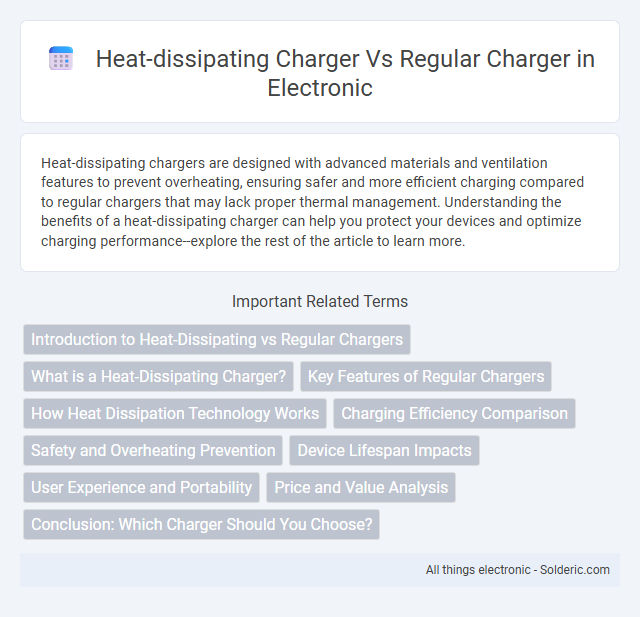Heat-dissipating chargers are designed with advanced materials and ventilation features to prevent overheating, ensuring safer and more efficient charging compared to regular chargers that may lack proper thermal management. Understanding the benefits of a heat-dissipating charger can help you protect your devices and optimize charging performance--explore the rest of the article to learn more.
Comparison Table
| Feature | Heat-Dissipating Charger | Regular Charger |
|---|---|---|
| Heat Management | Advanced heat dissipation technology reduces overheating | Basic design with limited heat control |
| Charging Speed | Maintains optimal speed by preventing thermal throttling | May slow down due to overheating |
| Durability | Longer lifespan due to efficient heat handling | Shorter lifespan caused by heat damage |
| Safety | Lower risk of fire and overheating hazards | Higher risk of overheating-related issues |
| Design | Incorporates heat sinks, vents, or cooling materials | Simple casing without specialized cooling features |
| Price | Typically higher due to advanced cooling technology | Usually more affordable |
Introduction to Heat-Dissipating vs Regular Chargers
Heat-dissipating chargers are designed with advanced materials and ventilation systems to efficiently disperse heat generated during charging, preventing overheating and enhancing device safety and longevity. Regular chargers often lack specialized cooling features, which can lead to higher operating temperatures, potentially reducing charging efficiency and increasing the risk of damage to your device. Choosing a heat-dissipating charger ensures more stable performance and better protection for your electronics during extended use.
What is a Heat-Dissipating Charger?
A heat-dissipating charger is designed with advanced materials and ventilation features to efficiently manage and reduce heat buildup during charging, ensuring safer and more stable energy transfer. Unlike regular chargers that may overheat and risk damaging your device or reducing battery lifespan, heat-dissipating chargers maintain optimal temperatures, enhancing charging speed and durability. Choosing this type of charger helps protect your device's battery health by preventing thermal stress and improving overall charging efficiency.
Key Features of Regular Chargers
Regular chargers typically feature a standard design focused on basic power delivery without specialized heat management systems. These chargers often use conventional plastic housing and standard circuitry, which can lead to increased heat generation during prolonged use. They generally lack advanced thermal protection mechanisms, making them less efficient in dissipating heat compared to heat-dissipating chargers.
How Heat Dissipation Technology Works
Heat-dissipating chargers utilize advanced materials and design techniques, such as built-in heat sinks, thermal conductive pads, and improved airflow channels, to effectively disperse heat generated during charging. These chargers regulate temperature by transferring excess heat away from critical components, preventing overheating and enhancing device safety and longevity. In contrast, regular chargers lack these specialized cooling mechanisms, often leading to higher surface temperatures and reduced charging efficiency.
Charging Efficiency Comparison
Heat-dissipating chargers maintain lower internal temperatures during use, resulting in more stable voltage output and faster charging speeds compared to regular chargers that tend to overheat. This improved thermal management reduces energy loss, enhancing your device's overall charging efficiency and prolonging battery health. Choosing a heat-dissipating charger ensures optimal power delivery and prevents throttling common in conventional chargers.
Safety and Overheating Prevention
Heat-dissipating chargers feature advanced thermal management technologies such as graphene or aluminum alloy heat sinks that efficiently dissipate heat, significantly reducing the risk of overheating compared to regular chargers. These chargers incorporate smart temperature sensors and built-in safety protocols to automatically regulate power output and shut down in cases of excessive heat, preventing potential fire hazards and device damage. In contrast, regular chargers often lack these safeguards, making them more prone to overheating issues that can compromise safety and device longevity.
Device Lifespan Impacts
Heat-dissipating chargers reduce device temperature during charging, significantly extending the lifespan of your electronics by preventing overheating-related damage. Regular chargers often allow heat to accumulate, which can degrade battery capacity and shorten overall device life. Choosing a heat-dissipating charger helps maintain optimal operating temperatures, preserving battery health and ensuring longer-lasting performance.
User Experience and Portability
Heat-dissipating chargers enhance user experience by maintaining lower temperatures during charging, reducing the risk of device overheating and improving charging efficiency. These chargers often feature advanced cooling technologies, making them safer for prolonged use and ideal for high-capacity devices. Compared to regular chargers, heat-dissipating models typically maintain compact and lightweight designs, ensuring portability without sacrificing performance.
Price and Value Analysis
Heat-dissipating chargers typically come at a higher price due to advanced materials and design that improve heat management and prolong device lifespan. While regular chargers are more affordable upfront, they may generate excess heat, potentially reducing charging efficiency and increasing wear on your device. Investing in a heat-dissipating charger offers better long-term value by enhancing safety, reliability, and overall performance.
Conclusion: Which Charger Should You Choose?
Heat-dissipating chargers offer superior thermal management, reducing the risk of overheating and enhancing charging efficiency compared to regular chargers. Devices charged with heat-dissipating technology tend to maintain battery health longer, providing safer and more reliable performance. For optimal device longevity and faster, stable charging sessions, a heat-dissipating charger is the preferable choice over standard chargers.
heat-dissipating charger vs regular charger Infographic

 solderic.com
solderic.com